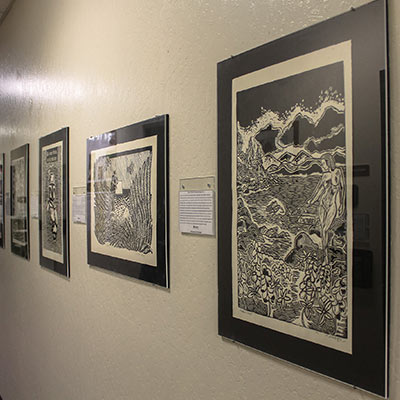
These pieces from the Permanent Collection hang in RDMT 334, and are part of a collection called "Colour Blinders."
The TMCC Permanent Collection
There is a colorful painting near Stairwell 9 in the Red Mountain Building that catches the eye. The mixed media piece is noticeable due to its size (it is eight feet tall and four feet wide), and has been known to elicit positive reactions from students and staff. The piece, called Morph, is a part of TMCC’s Permanent Art Collection, and an asset that gives our campus unique access to not only its history, but to its living culture.
The Collection was established in 2001, under the purveyance of Nolan Preece who was the TMCC Galleries Curator from 2001–2010. Candace Garlock managed the collection—and the various galleries around campus—until two years ago when Aimee Kelly, TMCC’s Art Galleries Curator & Instructor, assumed responsibility of the galleries and the Permanent Collection.
Kelly remembers that, two years ago, only 25 pieces were displayed across campus. Today the number of pieces of art on display across the Dandini Campus and other Centers has grown to 85, with 77 more pieces slated for display through spring of 2019.
Art in Campus Spaces
TMCC’s Permanent Art Collection is comprised of an eclectic mix of media and style, which the college has acquired primarily through donation. The collection, which began at a value of $2,800, is now valued at over $87,000 and is, piece by piece, adding depth, color and beauty to indoor and outdoor campus spaces.
The job of selecting what art goes where--and why-- is no easy task, however, and Kelly admits there are several different methods she utilizes. “Sometimes, I look at where the art will go, like what is being taught there, and match the art to the discipline.” She cited a recent example of the William N. Pennington Applied Technology Center—where technical training courses are held— that features art with a distinct industrial feel.
Other times, she says, she leaves the selection of what art to hang in a space up to the staff who work there, within reason. The only inarguable rule, when it comes to selecting art to hang on a wall has less to do with aesthetics than it does accessibility. Art—and especially art in the Permanent Collection—is intended to be available for public access.
“It has to be hung in a public place,” said Kelly. “So, you won’t ever find pieces in the collection hanging in private offices.”
You can expect to see more Permanent Collection art around the Dandini Campus and other program sites soon: the TMCC DISCO, Counseling Center and Library are all on the list for future installations.
The Value of Public Art
What is the value of having art in public spaces? In a 2015 article “Art in Public Spaces” published by The New York Times, writer Brooke Karmin Rapaport claimed that “Public art is a communal activity; its reach can be powerful for communities [...There is a] democratic ideal in [it because public art is] free for all viewers.” Art around functions in a similar capacity, inviting visitors, students, faculty and staff to participate in the emotional and intellectual world of art, if even for a second.
“There’s also an educational value to having art available to view on campus,” Kelly said. “Visual language is changing, and having visual influences around us can help to form that language that shifts quickly due to new technologies.”
Culture, too, is a function of visual art. “Art helps to bridge cultural gaps, or can open discussions about cultural issues. Even if you don’t ‘know about art’—experiencing it can be educational,” said Kelly.
Although the Permanent Collection has grown considerably—especially in recent years—it is by no means at a stopping point. In addition to adding more art indoors, Kelly is also working on an outdoor sculpture garden. “The art is not only a financial asset to our institution, but it is a statement about what we value and why.”
The painting Morph—like much of the art on display—receives not only attention, but love. Kelly said that she has had students tell her: “That painting just puts a smile on my face.”
More information
If you are interested in knowing more about TMCC’s Permanent Art Collection, an entire directory—listing the names of art, the artist(s) who created the work and its location—are listed on the Permanent Art Gallery Collection page.
If you want to help get more of the Permanent Collection on display, please email Aimee Kelly, who is looking for volunteers to assist with the acquisition and curation of the Permanent Collection.






